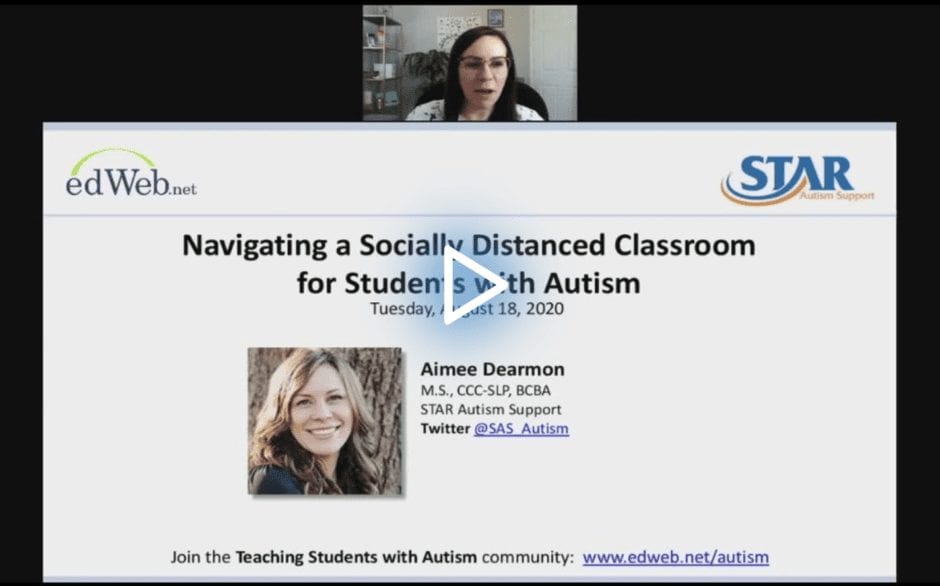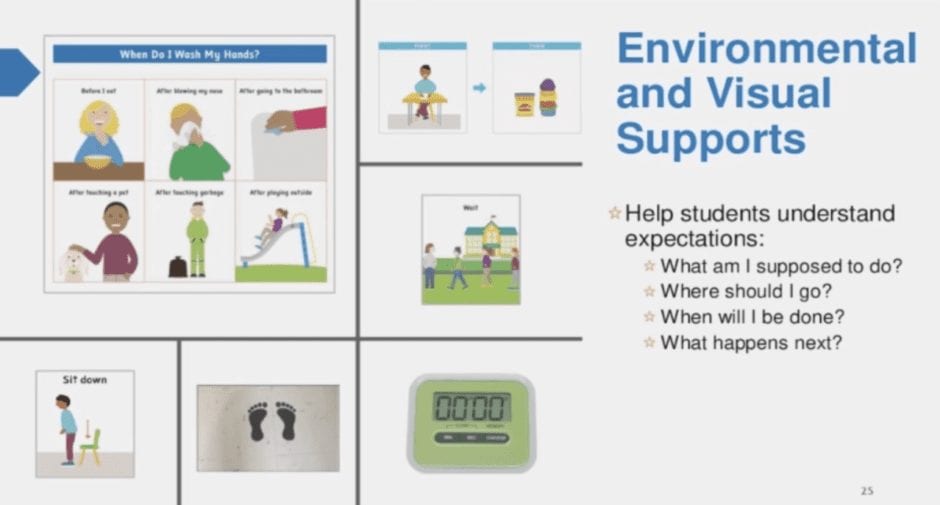Navigating a Socially Distanced Classroom for Students with Autism
By Eileen Belastock
While most educators and students are returning to the familiar classrooms left abruptly in March, teaching this upcoming year will be anything but business as usual. According to Aimee Dearmon, Speech and Language Pathologist (SLP) and Board Certified Behavior Analyst (BCBA), in a recent edWebinar sponsored by STAR Autism Support, the disruption of routines, schedules, classroom layouts, and necessary social distancing protocols will be very difficult for our most vulnerable students with autism and other developmental disabilities.
Even under the best circumstances, these populations struggle to adjust to changes, and now the struggle will be exacerbated due to COVID-19 safety protocols. Dearmon emphasizes that schools and educators need to develop safe and healthy classroom action plans for students with autism and other disabilities that include environmental arrangement, classroom organization, rotations, hygiene, and material sharing. The biggest challenge with developing classroom action plans is establishing the same level of support to these students while maintaining social distancing. Educators need to craft strategies and processes that meet health guidelines and ensure that students understand and adapt to new routines and behavioral expectations.
Dearmon recommends social scripts, video modeling, visual supports, and prompts. Using these ABA reinforcement tools, students with autism and other developmental disabilities can learn simple distancing protocols such as how to wear a mask, walk in the hallway, and remain apart from others in the school setting. Learning new routines establishes a level of comfort for these students to understand and allows them to predict how, what, where, and when learning will happen. When educators utilize the tools, there is a significant reduction in student anxiety and stress resulting in new habit formation. It is essential to remember to give students cues one time to provide a direction one time and then provide the students with a little bit of wait time.
It is crucial to recognize that we may overprompt students or offer too much assistance. Dearmon cautions that these strategies will result in students not having the necessary time to learn skills associated with socially distance protocols. She recommends starting with a less intense approach with verbal, visual prompts, or gesture prompts and, when necessary, moving to a model timely. The new school year will be stressful for students with autism and other developmental disabilities. It is crucial that school districts take the time, use researched-based strategies, and design thoughtful learning opportunities that set students up for success—three to six feet away from each other.
This edWeb broadcast was sponsored by STAR Autism Support.
This article was modified and published by eSchool News.
About the Presenter
Aimee Dearmon is a speech and language pathologist (SLP) and a Board Certified Behavior Analyst (BCBA) who has over 15 years of experience serving students with autism in public, private and home settings. In addition to providing workshops and training in schools across the country and Puerto Rico, Aimee works with STAR Autism Support to manage and develop large projects. Her work includes developing workshops, building training sites, and coaching staff to successfully implement the STAR Program, Links Curriculum, and the STAR Online Learning System in several states, regions, and districts. Aimee is passionate about raising awareness for autism in her community and has led fundraising efforts at the local and regional levels.
Join the Community
Teaching Students with Autism is a free professional learning community on edWeb.net that provides ideas and resources for teachers working with students with autism, particularly advances in technology that can lead to significant breakthroughs in communication and learning.

Eileen Belastock, CETL is the Director of Technology and Information for Nauset Public Schools, MA, and also works with edWeb.net to write articles on their professional learning edWebinars. You can follow Eileen on Twitter @EileenBelastock.





Comments are closed.